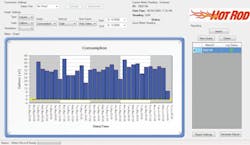Matt Thomas is vice president, sales and marketing for Mueller Systems. Thomas can be reached at [email protected] or 508.946.9163.
Nestled in the scenic Blue Ridge Mountains, the city of Clayton, Ga., is a small town with a big nonrevenue water problem. The International Water Assn. defines nonrevenue water as water that has been produced and is “lost” before it reaches the customer. According to the American Water Works Assn., such losses cost public water systems approximately $2.8 billion in yearly revenue.
Clayton was plagued with exceptionally high nonrevenue water rates in the 50% range. The city attributed the problem to leaks in its water system (parts of which have been in place since the 1920s), exasperated by high pressure levels needed to pump water to more than 3,200 service connections throughout Clayton’s mountainous terrain (located 2,200 ft above sea level). Furthermore, manual collection of meter readings across the city’s expansive service area was prone to human error and took as long as three weeks, making it virtually impossible to isolate leaks.
To help reduce nonrevenue water, improve customer service and reduce the amount of time required to collect monthly meter readings, Clayton began searching for an advanced, mobile automatic meter reading (AMR) system that could integrate with its newly replaced commercial and residential water meters.
Automatic Reading
The city turned to Cleveland, N.C.-based Mueller Systems, a subsidiary of Mueller Water Products Inc. Clayton’s Public Works Department decided to implement the company’s AMR system Hot Rod. The system components, including the Hot Rod radio transmitter unit, Street Machine mobile data collector and EZ Reader software, work together to help utilities reduce the amount of time it takes to manually collect meter reads, more effectively manage water usage and improve customer service.
The AMR units transmit monthly consumption reads and leak and backflow alerts via radio frequency, while internally storing hourly consumption for up to 170 days (about six months) for retrieval. Street Machine and EZ Reader software—the system’s data management tools—automatically collect meter reads and instant data logging alarms as a meter reader drives along a selected route; they provide progress screens and route maps, which display collected readings and meters that still need to have their data collected.
Meter locations are represented graphically on route maps by blue icons that disappear as soon as readings are collected. If a leak, reverse-flow, no-flow or tamper alarm is received, the corresponding icon will change color, immediately prompting the meter reader to proactively approach customers about possible leaks or other service-related issues.
The AMR Advantage
As soon as the AMR system was in place, the city began experiencing positive results. Mobile data collection enabled the city to reduce reader errors and the time it took to collect monthly readings, according to Clayton Public Works Director Moody Barrick.
“Our service area is considerably spread out over a rural terrain,” Barrick said. “It used to take us at least three weeks to manually collect readings—a process that was not only time intensive but also prone to human error. With the Hot Rod AMR System, it takes us 16 hours or less to collect monthly readings from each of our 3,200 service connections using only one meter reader. Mobile data collection has dramatically improved the accuracy of collected readings, and it has reduced our labor costs by approximately $40,000.”
Data logging and consumption profiling made possible by storage of 170 days of consumption data and alarms provided Clayton with detailed information that helped identify leaks and track nonrevenue water. As a result of the reduced water loss, which Clayton attributes to the AMR system as well as its meter replacement project, the Public Works Department has experienced an annual revenue increase of approximately $100,000.
“Prior to leveraging AMR, we were not able to isolate leaks due to limited data and the amount of time it would take to collect readings,” Barrick said. “Now, we are able to receive alerts of potential leaks and easily retrieve six months of historical usage data in the field, which we can use to isolate leaks by correlating individual readings with specific zones. This added efficiency is a primary contributor to the reduction in nonrevenue water we have experienced following the [system] implementation.”
The city also was able to improve its customer service using alarms and stored consumption data. “The city of Clayton is always looking for new ways to improve the level of service it provides to its customers,” Barrick added. “Alarms received through the Hot Rod system enable us to proactively inform customers of potential household water leaks that lose water they might otherwise be unknowingly billed for. Once an alarm is received, the meter reader can immediately alert the customer, or they can access hourly consumption data to further investigate the problem. [It] is also a great tool that helps our customer service representatives to resolve billing issues. They can retrieve the stored data and talk through it with customers to help them better understand their charges.”
Download: Here


